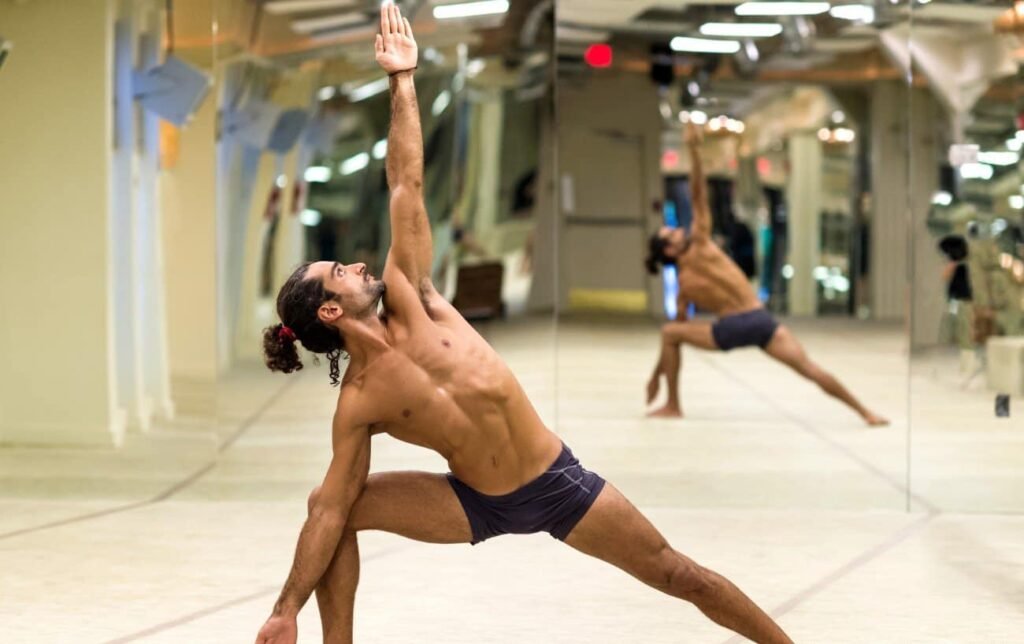
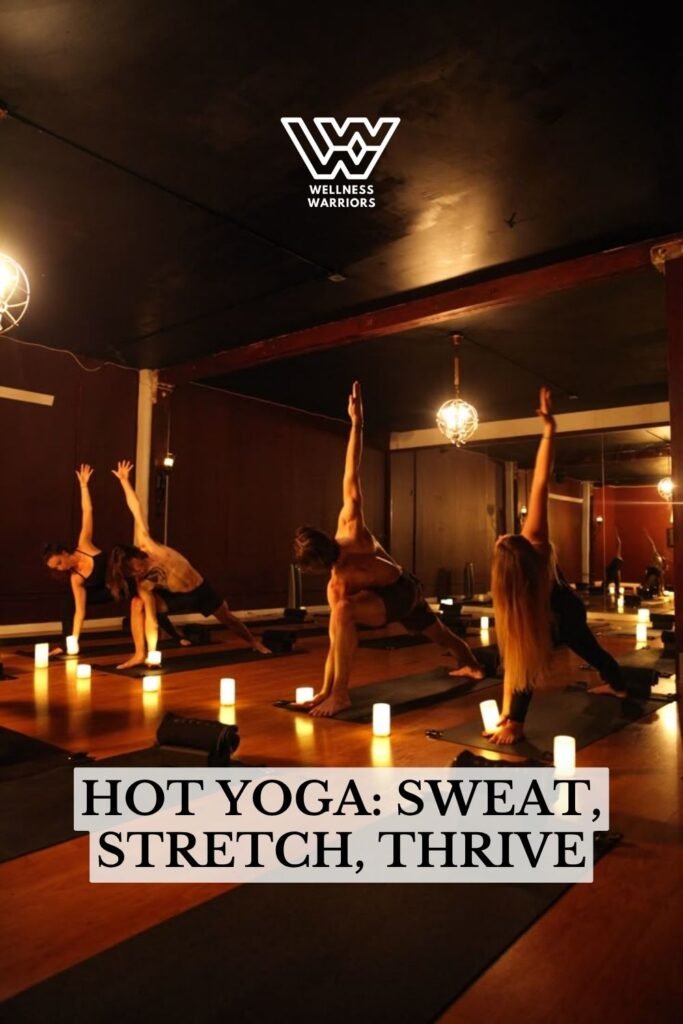
Bikram Hot Yoga Sequence: A Comprehensive Guide for Wellness Warriors
Welcome, Wellness Warriors! Today, we’re diving deep into the world of Hot Yoga, specifically focusing on the Bikram Hot Yoga sequence. This powerful and transformative style of yoga has gained immense popularity for its numerous health benefits and challenging nature. In this comprehensive guide, we’ll explore the Bikram sequence in detail, providing you with accurate information and entertaining insights to help you become an authority in this unique wellness practice.
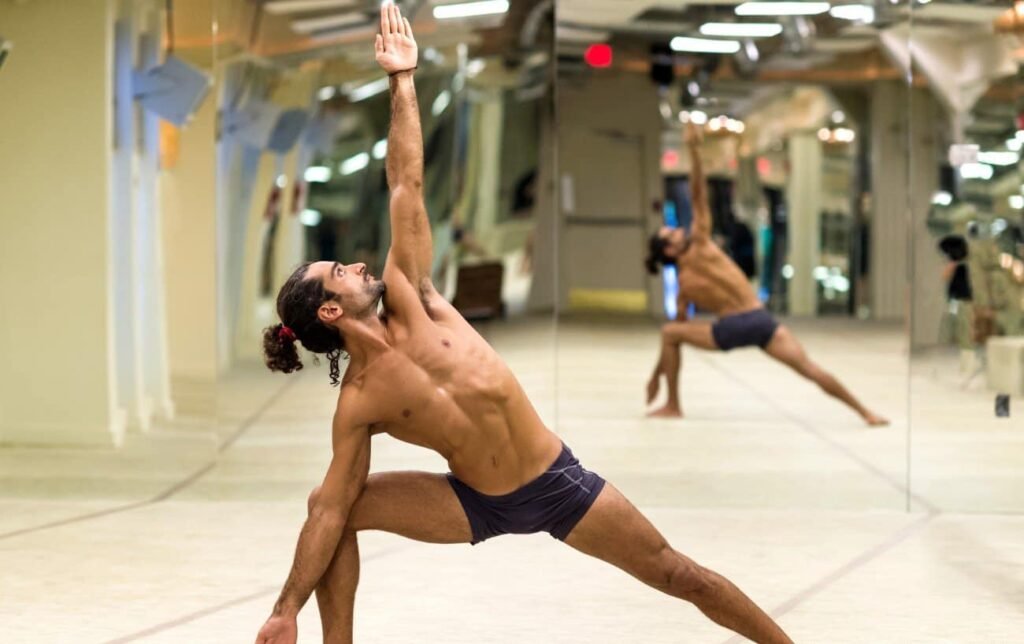
Introduction to Bikram Yoga
Bikram Yoga, named after its founder Bikram Choudhury, is a style of yoga practiced in a heated room. This form of hot yoga consists of a specific sequence of 26 postures and two breathing exercises, performed over a 90-minute session. The practice takes place in a room heated to approximately 105°F (40.6°C) with a humidity of 40%, creating a challenging and sweat-inducing environment.
The Bikram sequence is designed to work every part of the body, from the inside out. It aims to improve strength, flexibility, balance, and overall well-being. The heated room helps to warm up the muscles, increase flexibility, and promote detoxification through sweating.
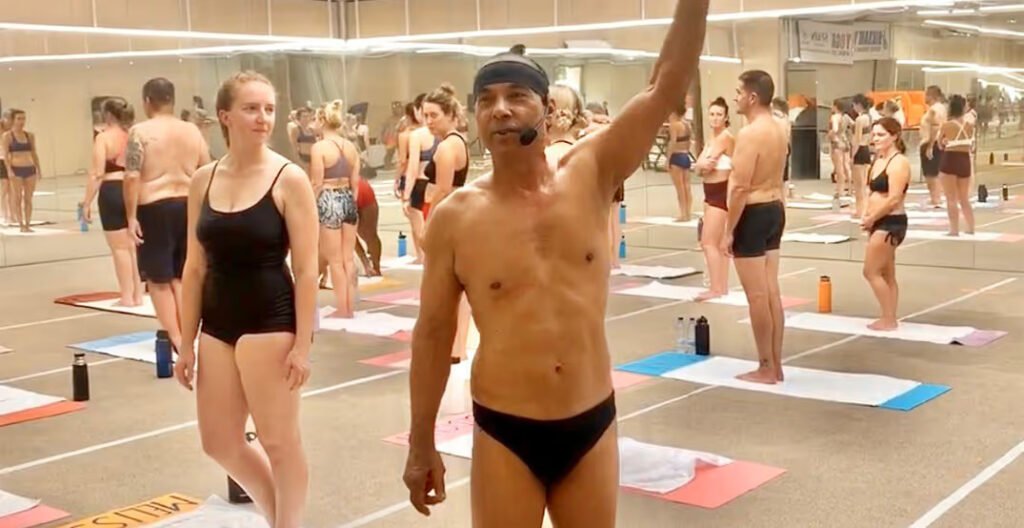
Quick History of Bikram Hot Yoga
Bikram Hot Yoga is a unique style of hot yoga that was popularized by Bikram Choudhury in the early 1970s. Choudhury, born in Kolkata, India, in 1946, began practicing yoga at a young age under the guidance of Bishnu Ghosh, a renowned physical culturist and the younger brother of Paramahansa Yogananda.The concept of practicing yoga in a heated environment originated when Choudhury was teaching in Japan. He observed that his students enjoyed using saunas during their breaks, which inspired him to experiment with heating his yoga studio.
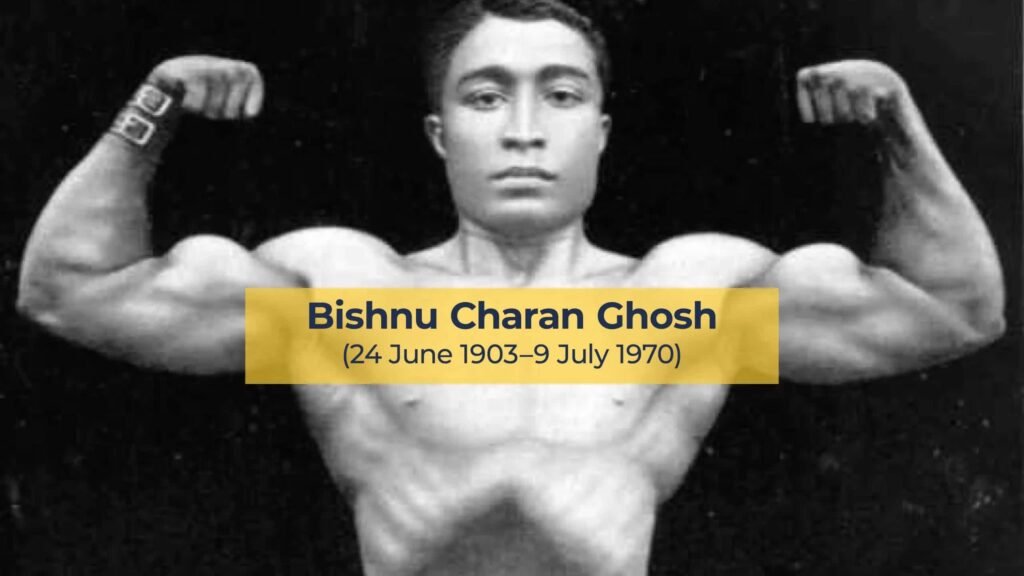
This led to the development of a structured sequence of 26 postures performed in a room heated to approximately 105°F (41°C) with high humidity, creating an environment that enhances flexibility and promotes detoxification through sweating. Bikram Hot Yoga quickly gained popularity in the United States, where it became synonymous with Bikram hot yoga. The practice is characterized by its fixed sequence of poses, which are designed to systematically work every part of the body, improving strength, flexibility, and overall health.
From the 1970s until around 2010, Bikram Hot Yoga was often regarded as the definitive form of hot yoga, inspiring many other styles and classes that adopted similar heated practices. However, the brand faced challenges in recent years due to controversies surrounding Choudhury, including legal issues and allegations of misconduct, which have impacted its reputation. Despite these challenges, Bikram Hot Yoga remains a significant part of the yoga landscape, continuing to attract practitioners who seek its unique benefits and rigorous practice.
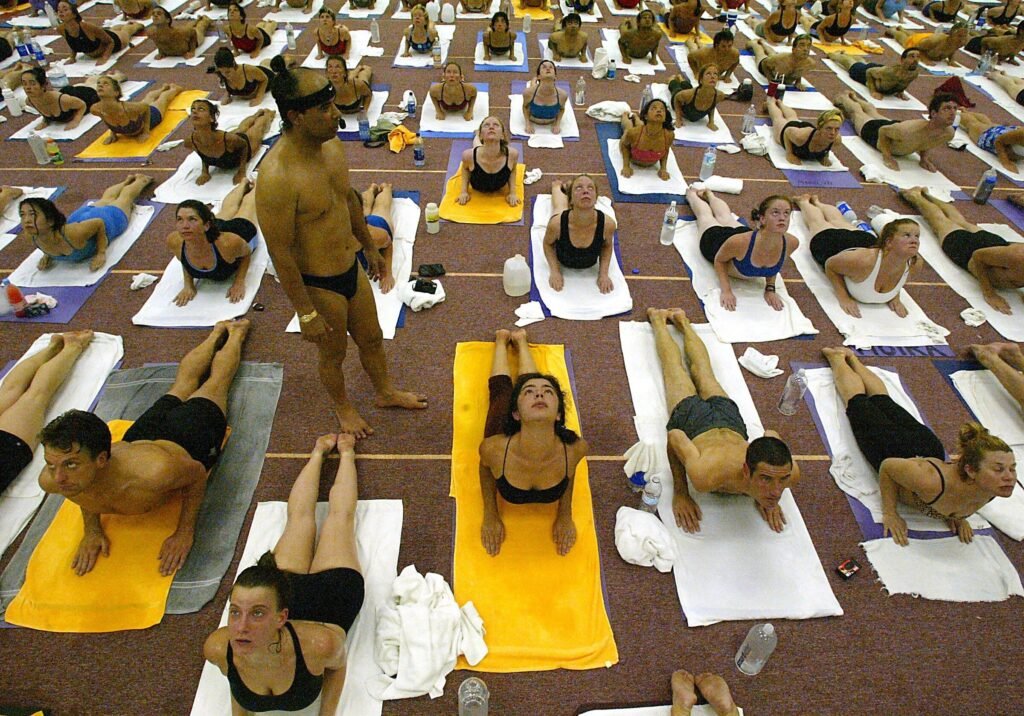
The Benefits of Hot Yoga Bikram Sequence
Before we delve into the specific poses, let’s explore some of the key benefits of practicing the Bikram sequence:
1. Improved Flexibility: The heat in the room allows for greater flexibility of the spine and other joints, reducing the risk of injury and improving overall range of motion.
2. Enhanced Cardiovascular Health: The combination of heat and challenging poses elevates the heart rate, providing a great cardiovascular workout.
3. Detoxification: Profuse sweating helps to flush toxins from the body, supporting the function of the immune system and internal organs.
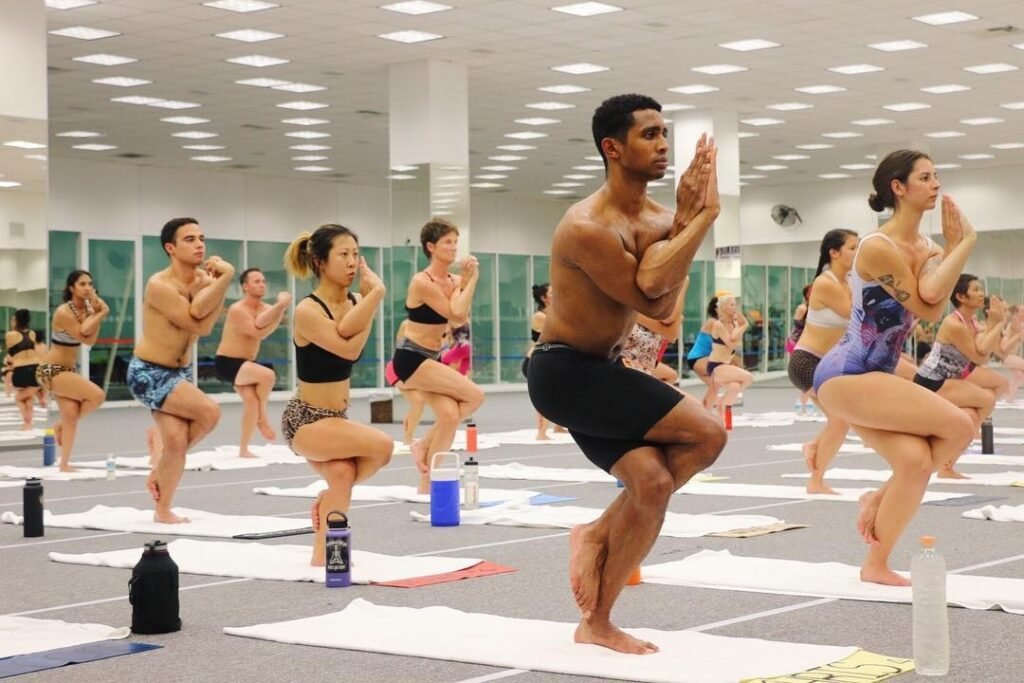
4. Stress Relief: The focus required during practice, combined with deep breathing exercises, helps to calm the nervous system and reduce stress.
5. Weight Loss: Hot yoga sessions can burn a significant number of calories, making it an effective tool for weight management.
6. Improved Circulation: The sequence of poses promotes better blood circulation throughout the entire body, delivering fresh blood and oxygen to various organs and tissues.
7. Pain Relief: Many practitioners report relief from lower back pain, knee pain, and other chronic discomforts.
8. Mental Clarity: The challenging nature of the practice promotes mental focus and clarity, carrying over into daily life.
Now, let’s explore the Bikram yoga sequence in detail, breaking down each pose and its benefits.
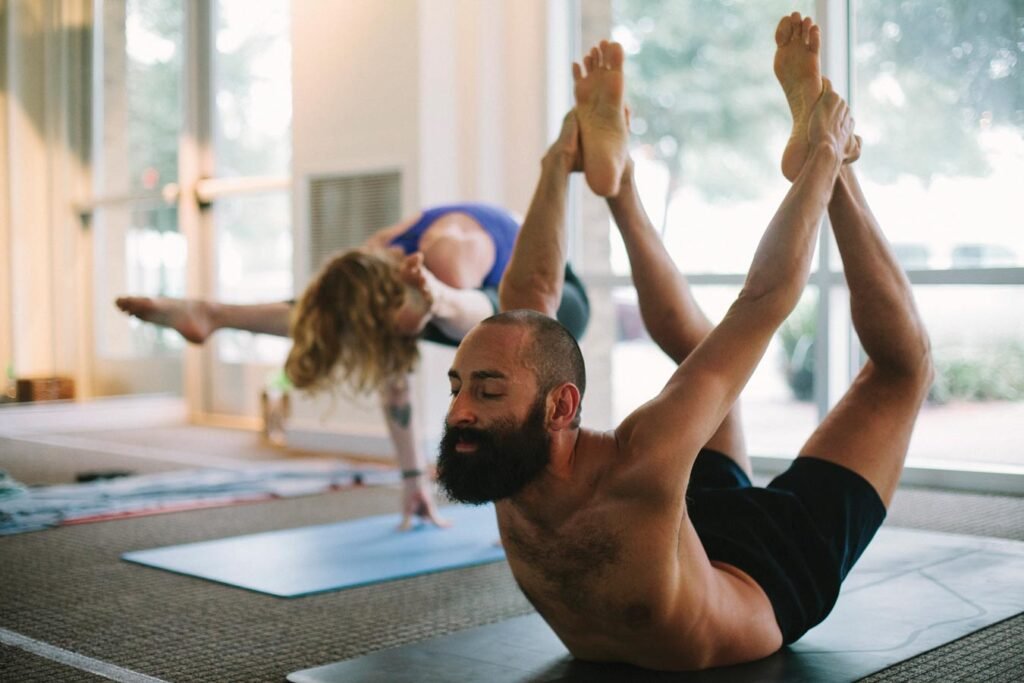
You also want to learn about Yin Yoga, click here!
The Bikram Yoga Sequence: 26 Poses and 2 Breathing Exercises
Pranayama (Breathing Exercise)
The Bikram Hot Yoga class begins with a deep breathing exercise to prepare the body and mind for the practice ahead. This exercise helps to oxygenate the blood, calm the nervous system, and focus the mind.
Standing Deep Breathing (Pranayama)
✔ Stand with feet together, hands interlocked under the chin
✔ Inhale deeply through the nose, lifting the elbows
✔ Exhale slowly through the mouth, lowering the elbows
✔ Repeat for 6-8 breaths

Standing Series
The standing series forms the first half of the Bikram sequence, focusing on building strength, balance, and flexibility in the lower body and core.
1. Half Moon Pose (Ardha Chandrasana) with Hands-to-Feet Pose
✔ Stand with feet together, arms over head
✔ Bend sideways, creating a crescent shape with the body
✔ Repeat on both sides
✔ Then, bend forward, touching the floor while keeping legs straight
Benefits: Stretches the entire body, particularly the side body, abdominal muscles, and hamstrings. Improves balance and spinal flexibility.
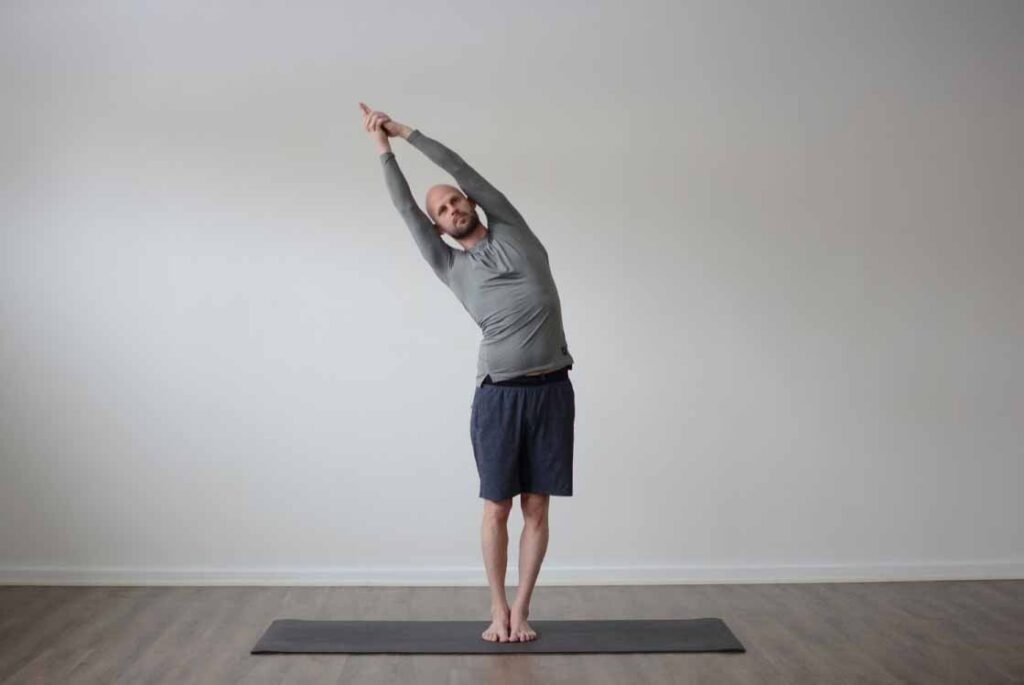
2. Awkward Pose (Utkatasana)
Perform three variations, each focusing on different aspects of the lower body
✔ First part: Rise onto toes, sink hips as if sitting in a chair
✔ Second part: Balance on heels, lifting toes
✔ Third part: Full squat with heels raised
Benefits: Strengthens the lower body, particularly the thighs, calves, and ankles. Improves balance and core strength.
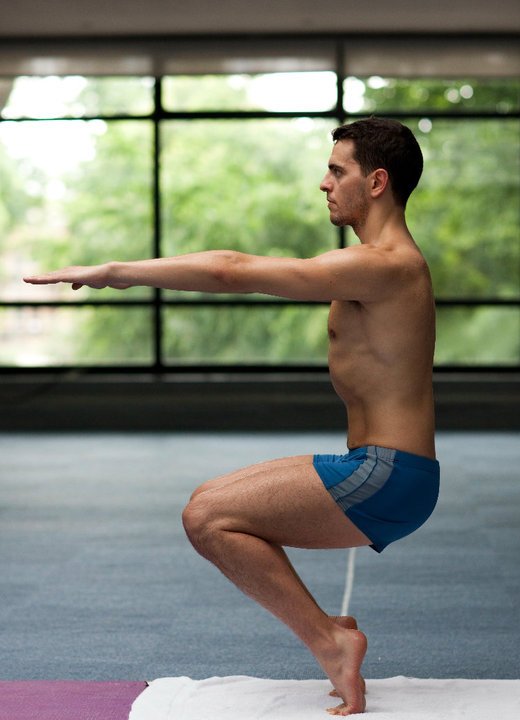
3. Eagle Pose (Garudasana)
✔ Stand on one leg, wrapping the other leg around the standing leg
✔ Wrap arms in front of the body
✔ Hold and repeat on the other side
Benefits: Improves balance, concentration, and flexibility in the hips and shoulders. Strengthens the legs and core.
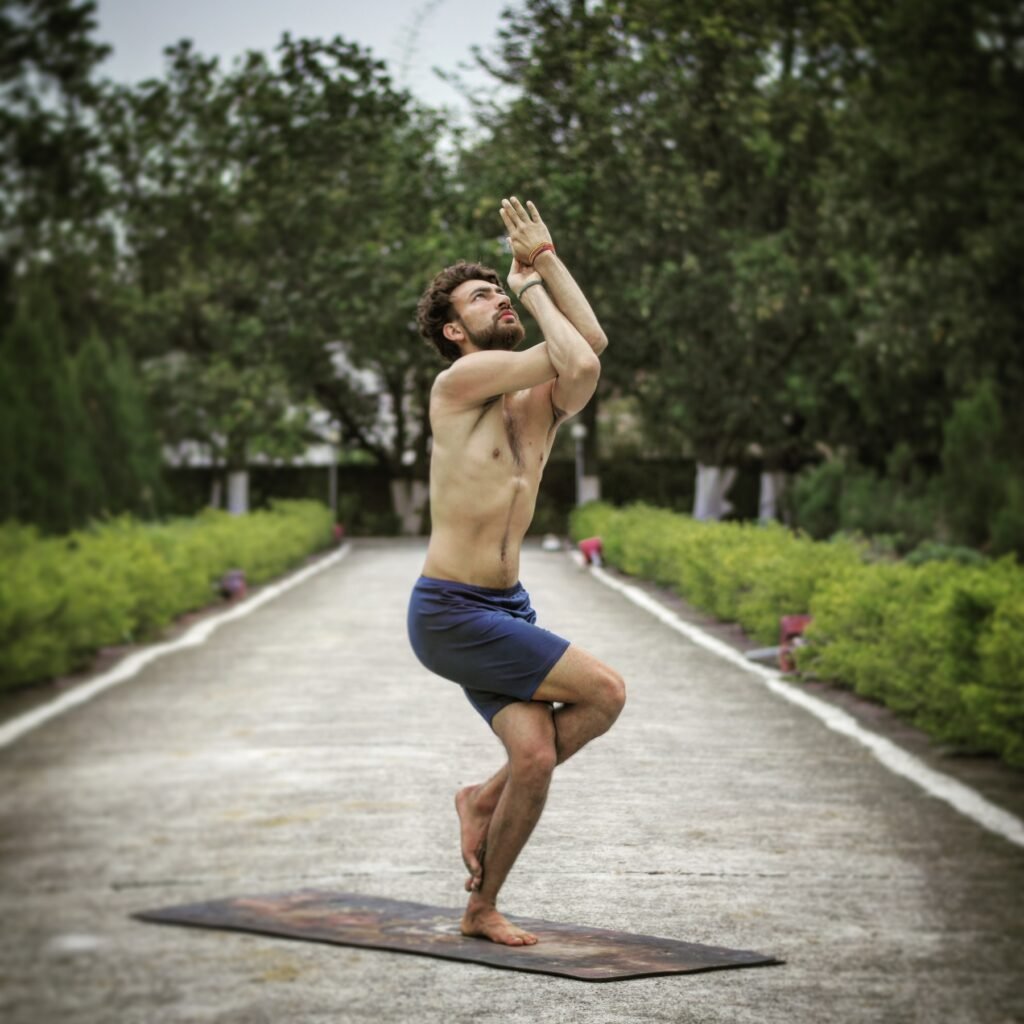
4. Standing Head-to-Knee Pose (Dandayamana-Janushirasana)
✔ Stand on one leg, holding the other foot with interlaced fingers
✔ Extend the held leg forward while bending the standing leg
✔ Bring forehead to knee if possible
Benefits: Improves balance, flexibility in the hamstrings and lower back. Strengthens the standing leg and core.
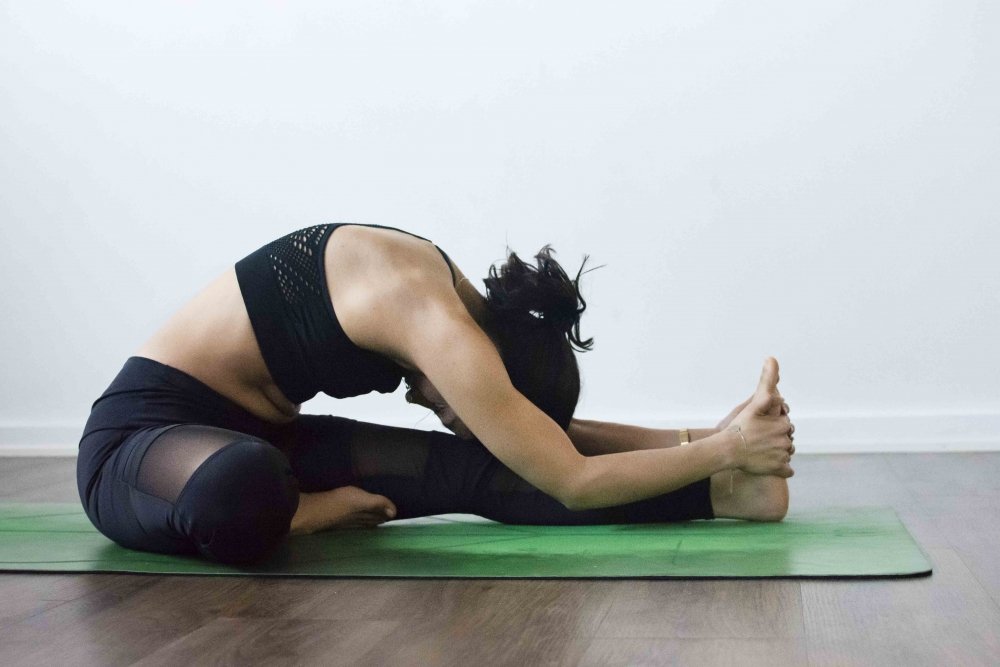
5. Standing Bow Pose (Dandayamana-Dhanurasana)
✔ Stand on one leg, grasp the other foot behind you
✔ Kick the held foot back while leaning forward
✔ Aim to create a “bow” shape with the body
Benefits: Improves balance, opens the chest, and strengthens the back muscles. Increases flexibility in the shoulders, spine, and legs.
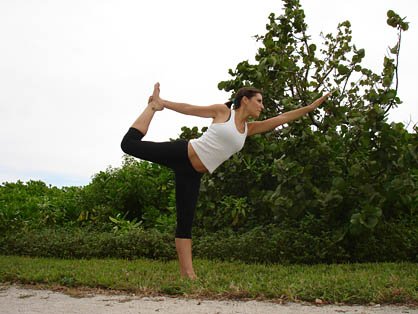
6. Balancing Stick Pose (Tuladandasana)
✔ Step forward, arms overhead
✔ Lean forward, lifting back leg until parallel to the floor
✔ Hold for 10 seconds, then switch sides
Benefits: Improves balance, strengthens the core and legs. Increases heart rate for cardiovascular benefits.
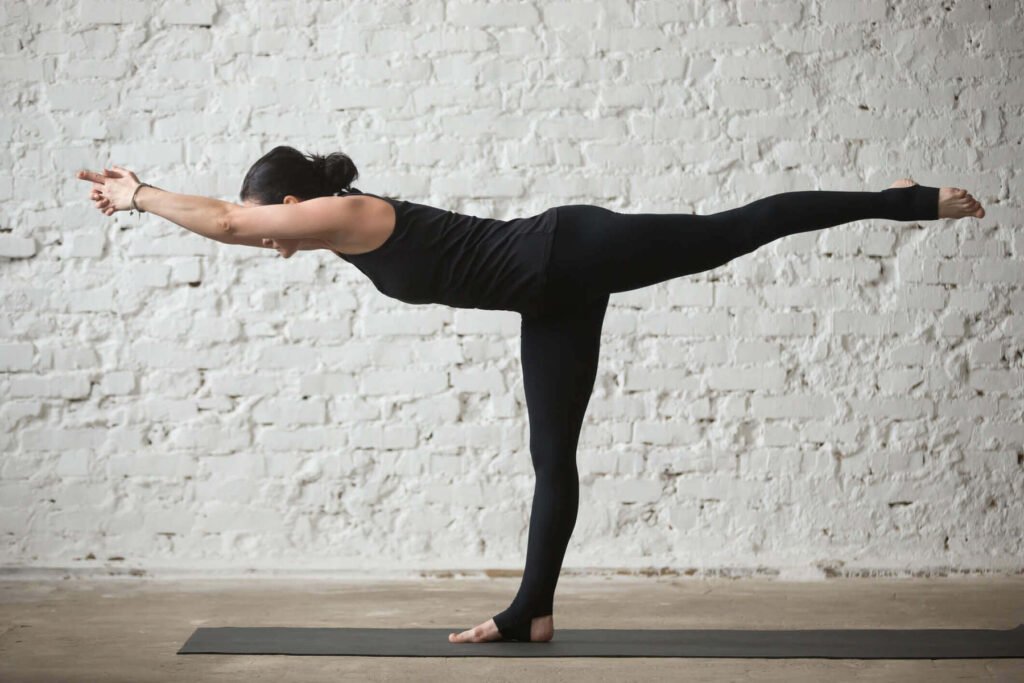
7. Standing Separate Leg Stretching Pose
✔ Wide stance with feet parallel
✔ Bend forward, grasping ankles or floor
✔ Keep legs straight and pull chest towards the floor
Benefits: Stretches hamstrings, calves, and lower back. Improves flexibility in the spine and stimulates abdominal organs.
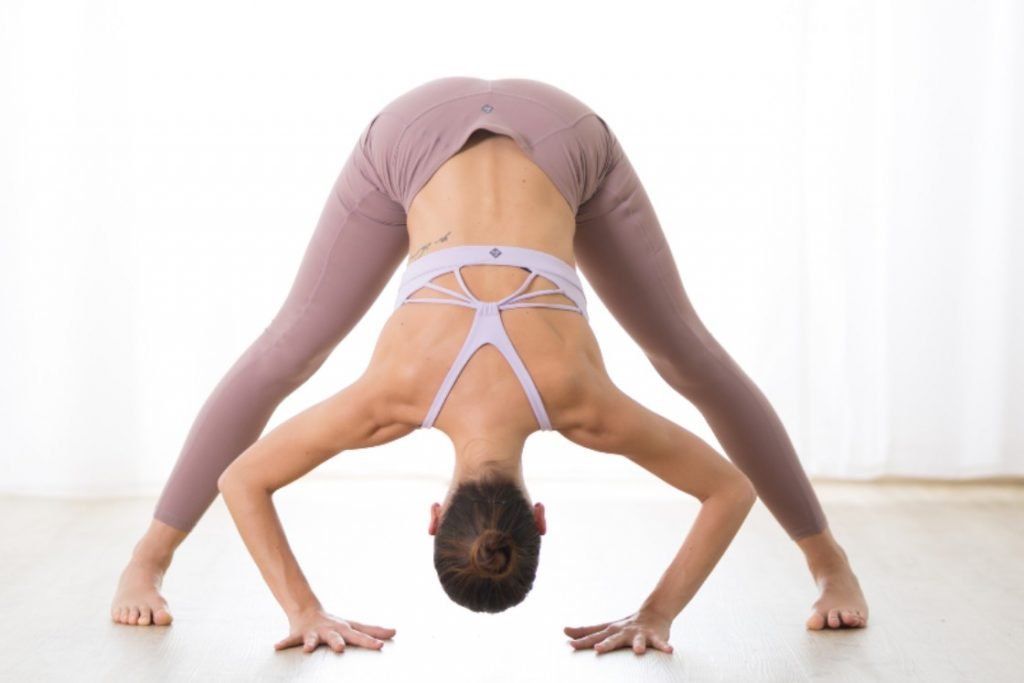
8. Triangle Pose (Trikonasana)
✔ stance, arms outstretched
✔ Bend to the side, reaching one hand to the floor, the other to the ceiling
✔ Repeat on both sides
Benefits: Strengthens the legs, stretches the spine, hips, and groin. Improves balance and stimulates abdominal organs.

9. Standing Separate Leg Head to Knee Pose
✔ Wide stance, turn one foot out
✔ Bend sideways over the turned-out leg
✔ Grasp foot with both hands, bringing forehead to knee if possible
Benefits: Stretches the sides of the body, hamstrings, and calves. Stimulates the liver, spleen, and kidneys.
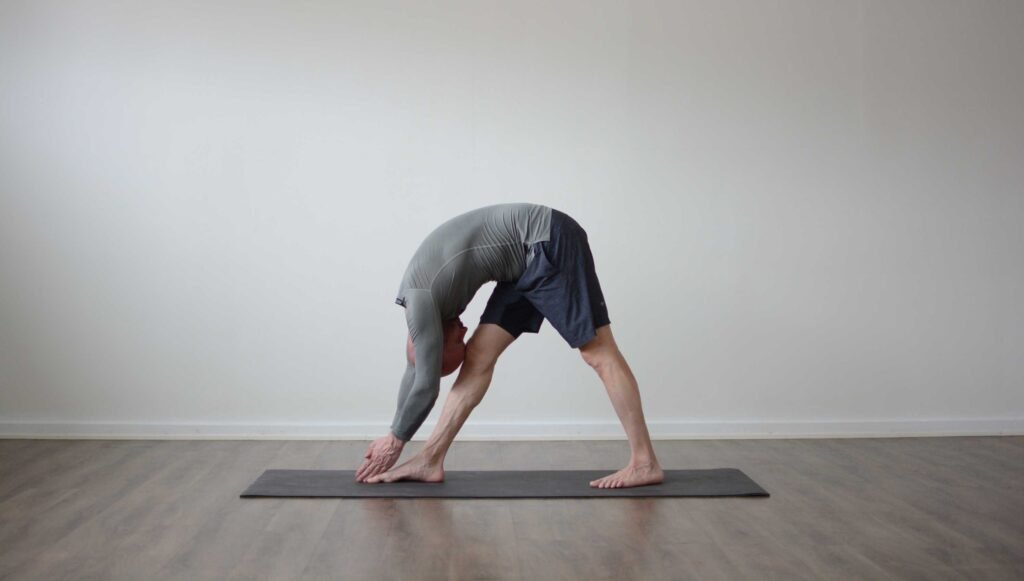
10. Tree Pose (Vrksasana)
✔ Stand on one leg, place other foot on inner thigh
✔ Bring hands to prayer position at chest
✔ Hold and repeat on the other side
Benefits: Improves balance, focus, and concentration. Strengthens the ankles, calves, and thighs.
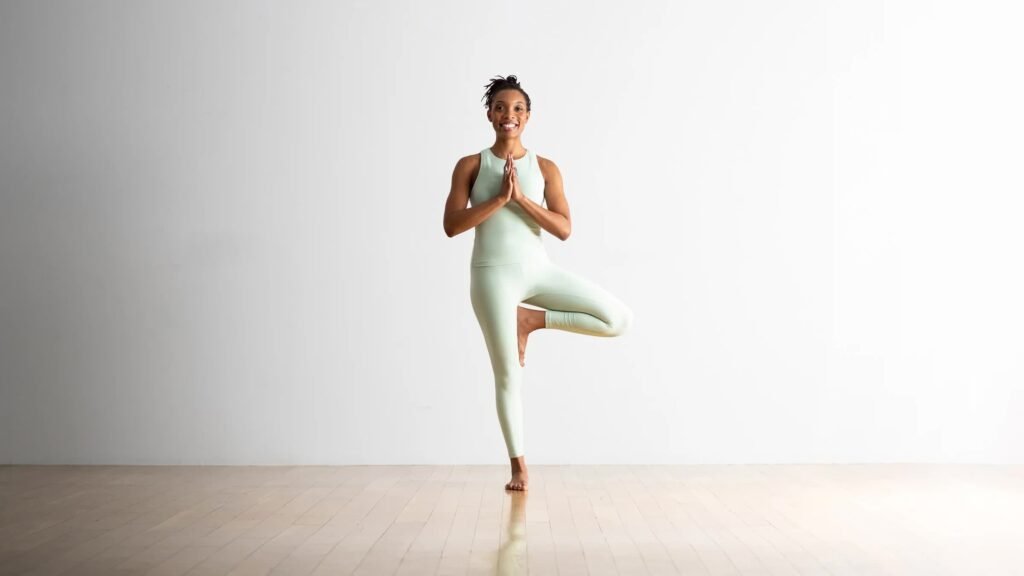
11. Toe Stand Pose
✔ From Tree Pose, slowly lower into a squat on the standing leg
✔ Balance on the ball of the foot
✔ Repeat on the other side
Benefits: Improves balance, strengthens the ankles and feet. Increases focus and concentration.
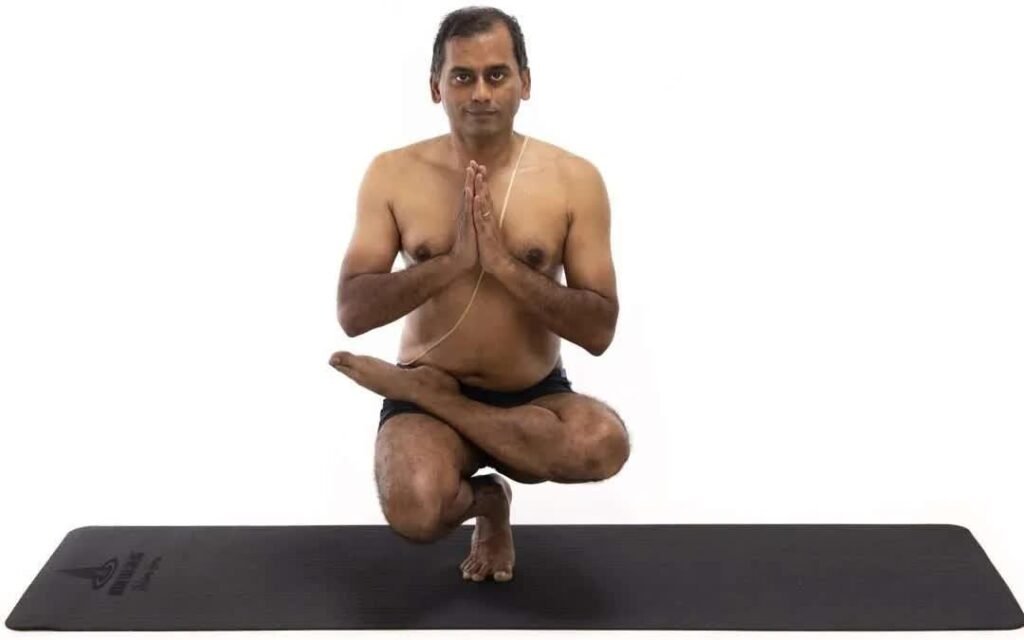
Floor Series
The floor series forms the second half of the Bikram Hot Yoga sequence, focusing on deep stretches, spinal twists, and core strengthening.
1. Dead Body Pose (Savasana)
✔ Lie on your back, arms at sides, palms up
✔ Close eyes and focus on relaxing each part of the body
Benefits: Allows the body to absorb the effects of the standing series. Calms the mind and nervous system.
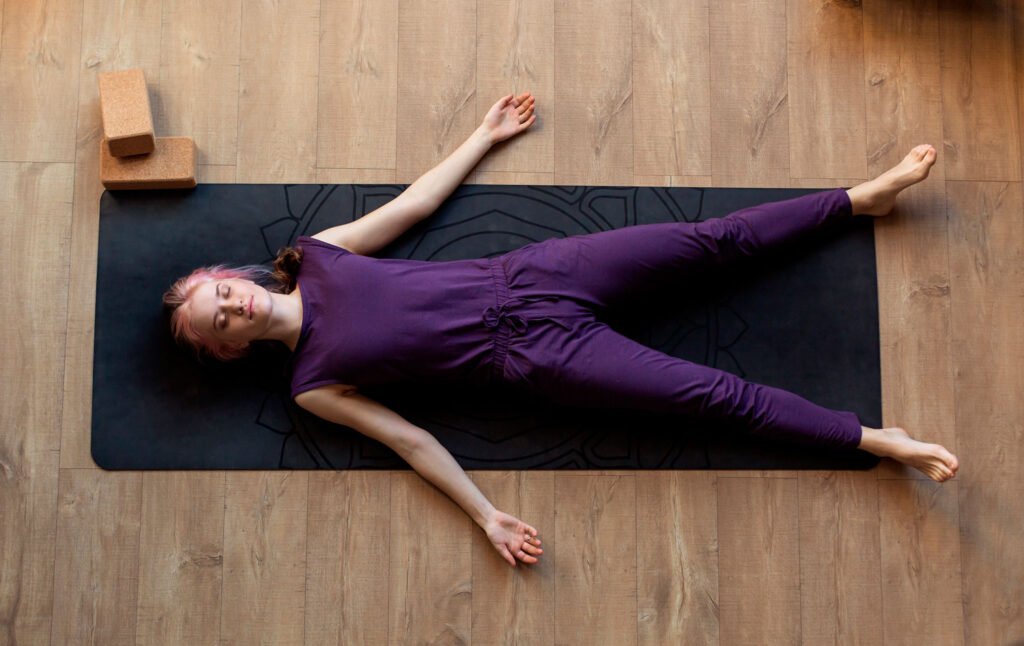
2. Wind-Removing Pose
✔ Lie on back, hug one knee to chest
✔ Repeat with the other leg, then both legs together
Benefits: Massages the colon and other abdominal organs. Relieves gas and bloating.
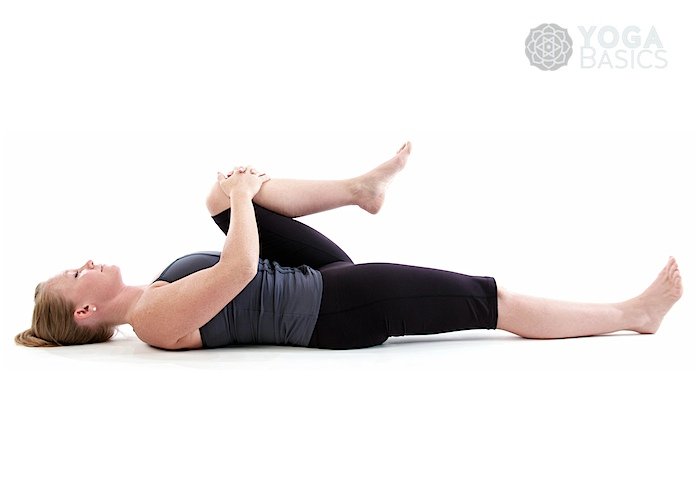
3. Sit-Up
✔ From lying position, interlace fingers behind head
✔ Lift upper body and lower body simultaneously, coming to a seated position
Benefits: Strengthens the core muscles, particularly the abdominals.
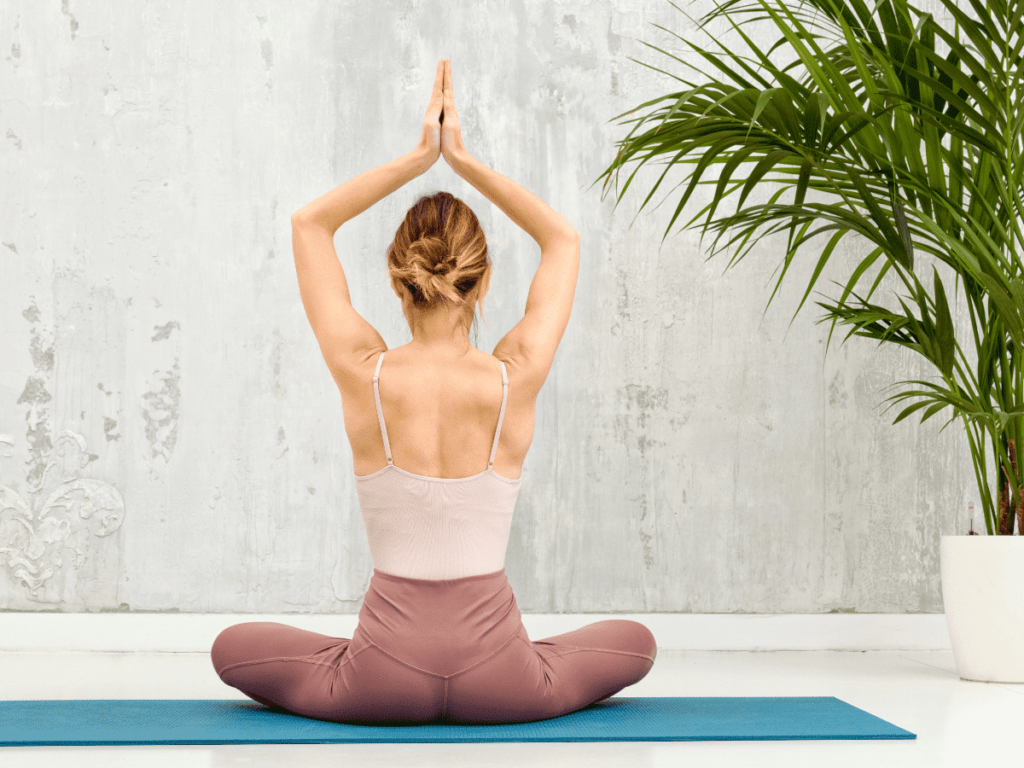
4. Cobra Pose (Bhujangasana)
✔ Lie face down, hands under shoulders
✔ Lift chest off the floor, keeping hips down
✔ Look up towards the ceiling
Benefits: Strengthens the back muscles, opens the chest, and stimulates the spine.

5. Locust Pose (Salabhasana)
✔Lie face down, arms at sides
✔ Lift legs and upper body off the floor
✔ Hold for 10 seconds
Benefits: Strengthens the entire back body, buttocks, and legs. Improves posture and spinal health.
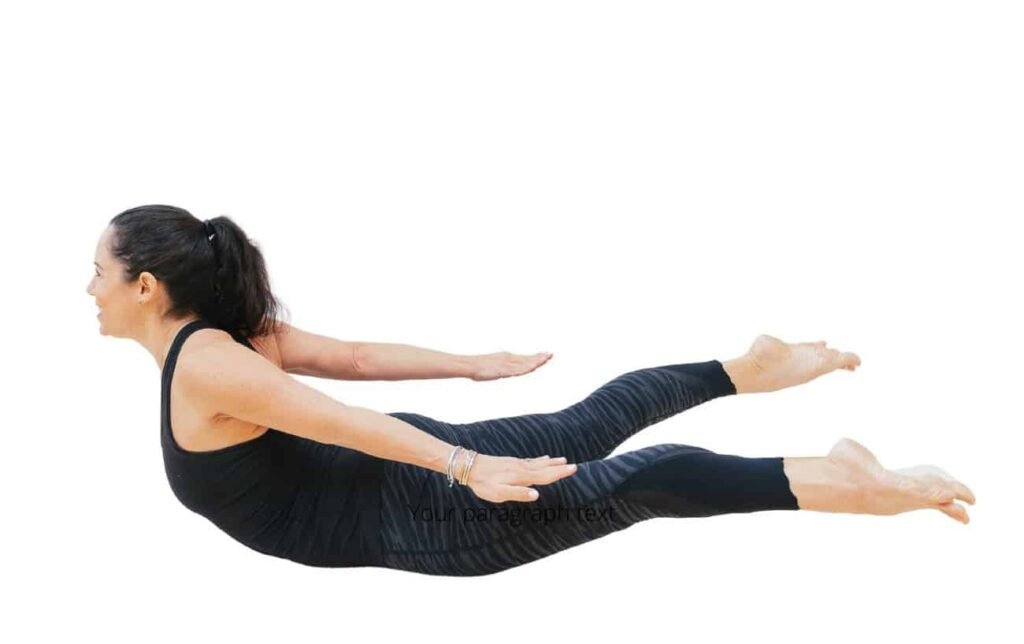
6. Full Locust Pose (Poorna Salabhasana)
✔ Similar to Locust Pose, but lift arms as well
✔ Attempt to lift the entire body off the floor
Benefits: Intensifies the effects of Locust Pose, further strengthening the back and improving spinal flexibility.
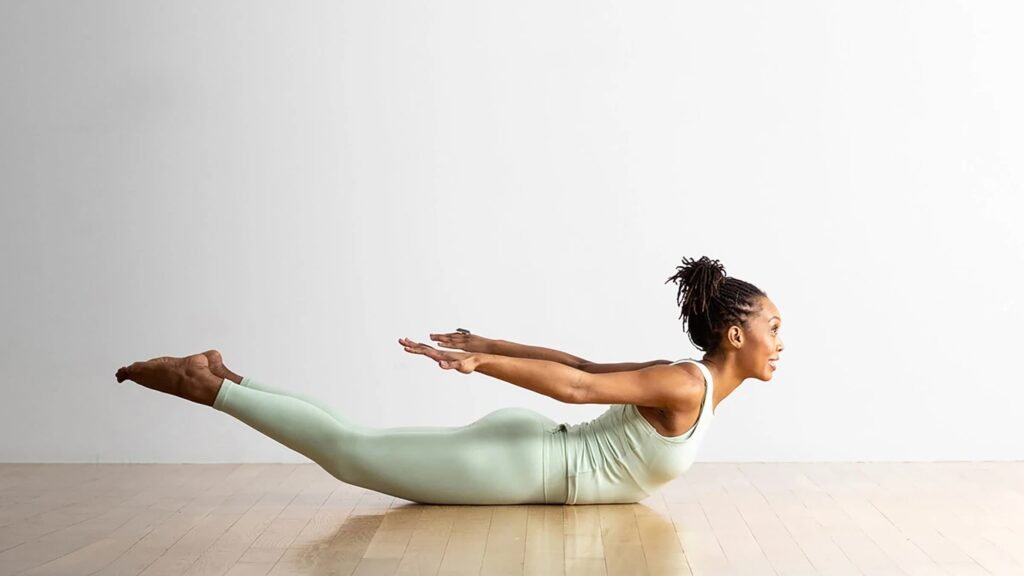
7. Bow Pose (Dhanurasana)
✔ Lie face down, bend knees and grasp ankles
✔ Lift chest and thighs off the floor, creating a bow shape
Benefits: Opens the chest, strengthens the back, and improves spinal flexibility.
Stimulates the digestive organs.
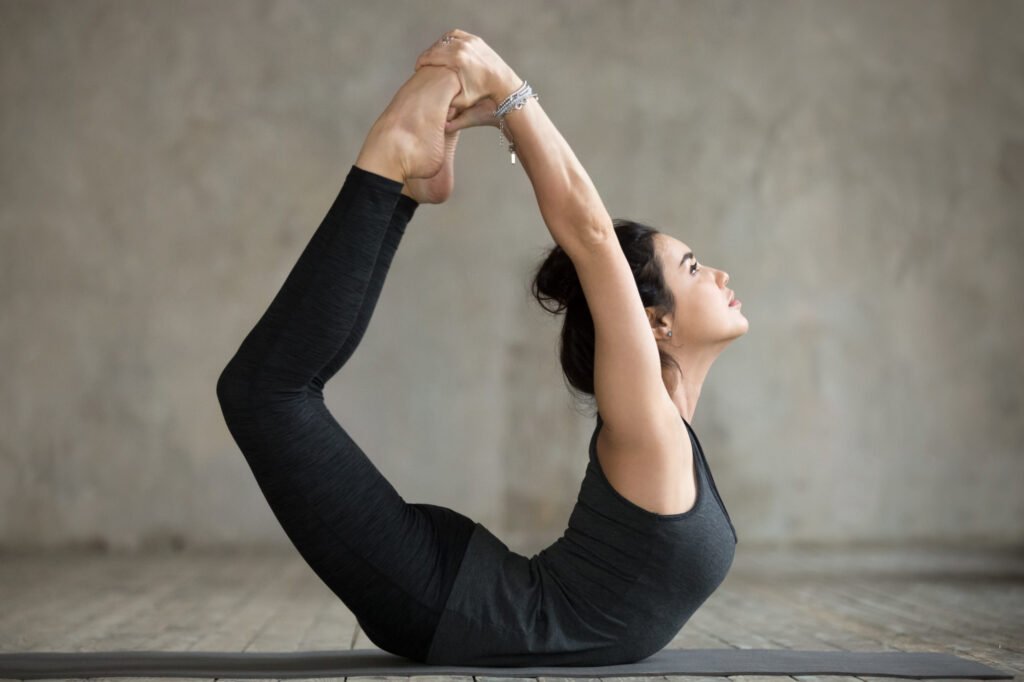
8. Fixed Firm Pose (Supta Vajrasana)
✔ Kneel with buttocks on heels
✔ Lean back, eventually lying back on the floor
✔ Stretch arms overhead
Benefits: Stretches the quadriceps, ankles, and knee joints. Improves flexibility in the lower back.
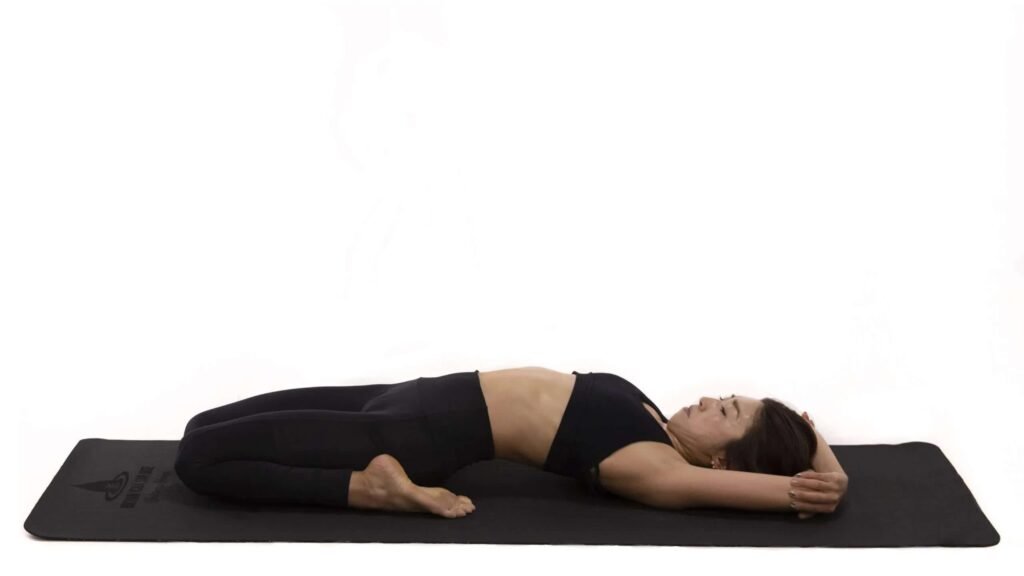
9. Half Tortoise Pose (Ardha Kurmasana)
✔ Sit on heels, stretch arms overhead
✔ Bend forward, bringing forehead to the floor
✔ Walk hands forward for a deeper stretch
Benefits: Stretches the lower back, shoulders, and arms. Calms the mind and relieves stress.
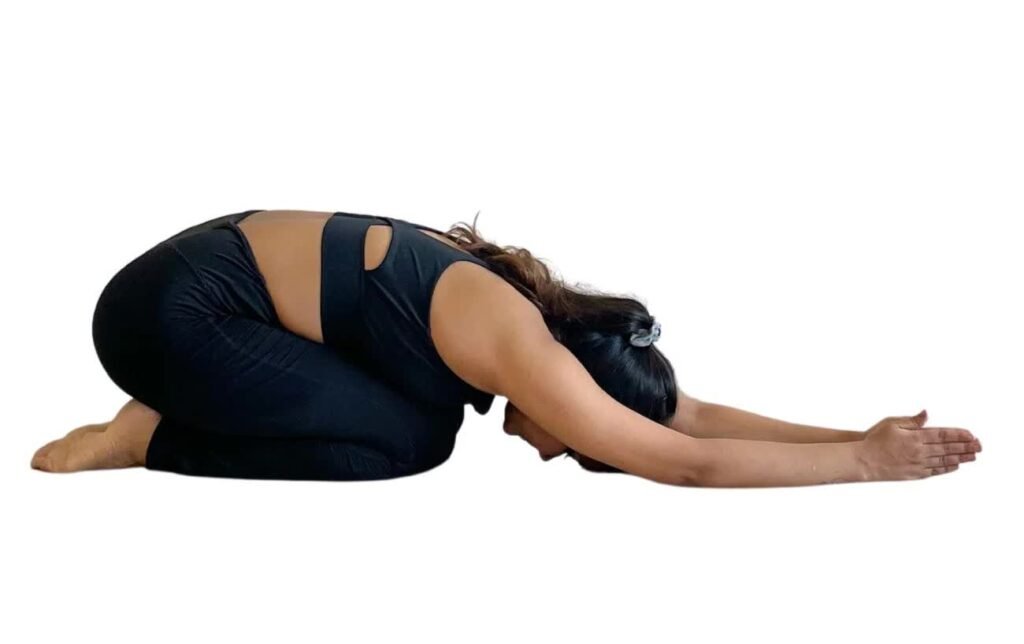
10. Camel Pose (Ustrasana)
✔ Kneel with hips over knees
✔ Lean back, grasping heels with hands
✔ Push hips forward, creating a deep backbend
Benefits: Opens the chest, stretches the front body, and improves spinal flexibility. Stimulates the thyroid and adrenal glands.
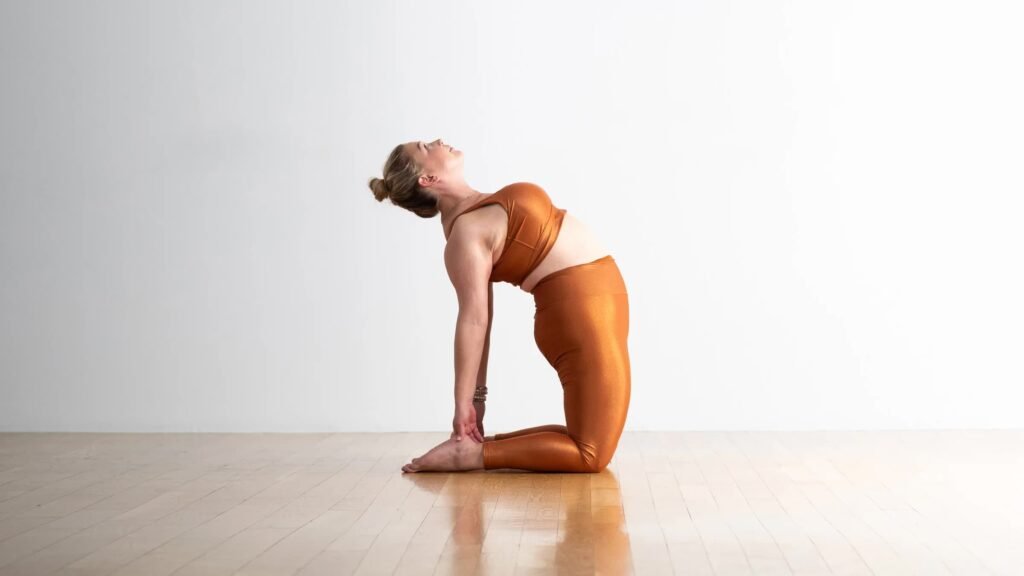
11. Rabbit Pose
✔ Sit on heels, grasp heels with hands
✔ Tuck chin to chest and roll forward, lifting hips
✔ Create a rounded spine, with forehead touching knees
Benefits: Stretches the spine in the opposite direction of Camel Pose. Stimulates the nervous system and thyroid gland.
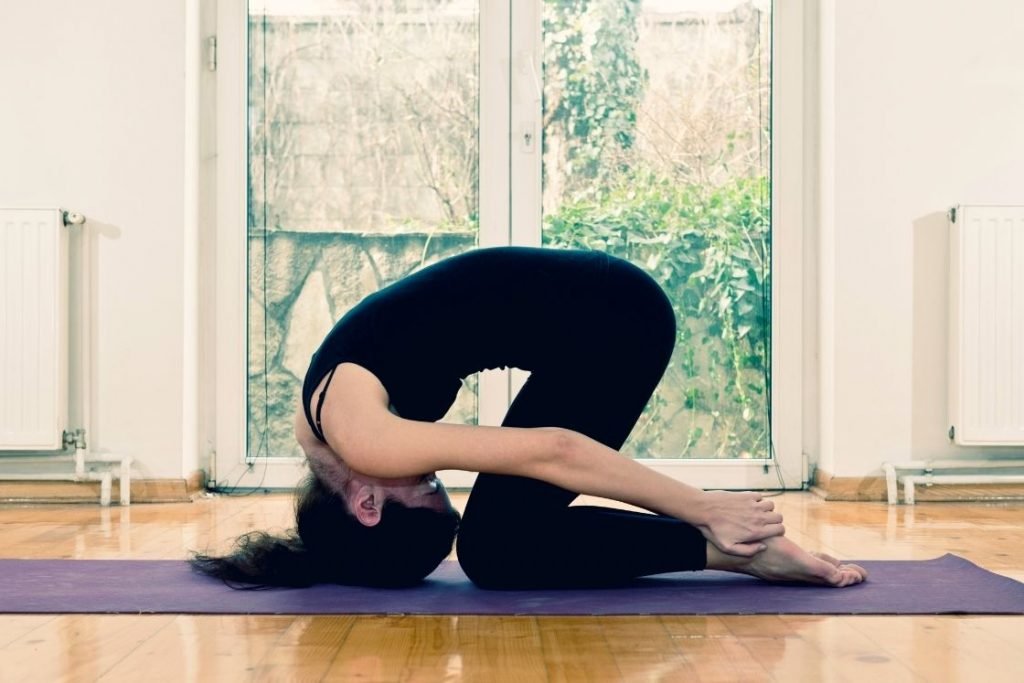
12. Head to Knee Pose with Stretching Pose
✔ Sit with one leg extended, other foot against inner thigh
✔ Bend forward over the extended leg, grasping foot
✔ Repeat on the other side
Benefits: Stretches the hamstrings, calves, and lower back. Stimulates the liver and kidneys.
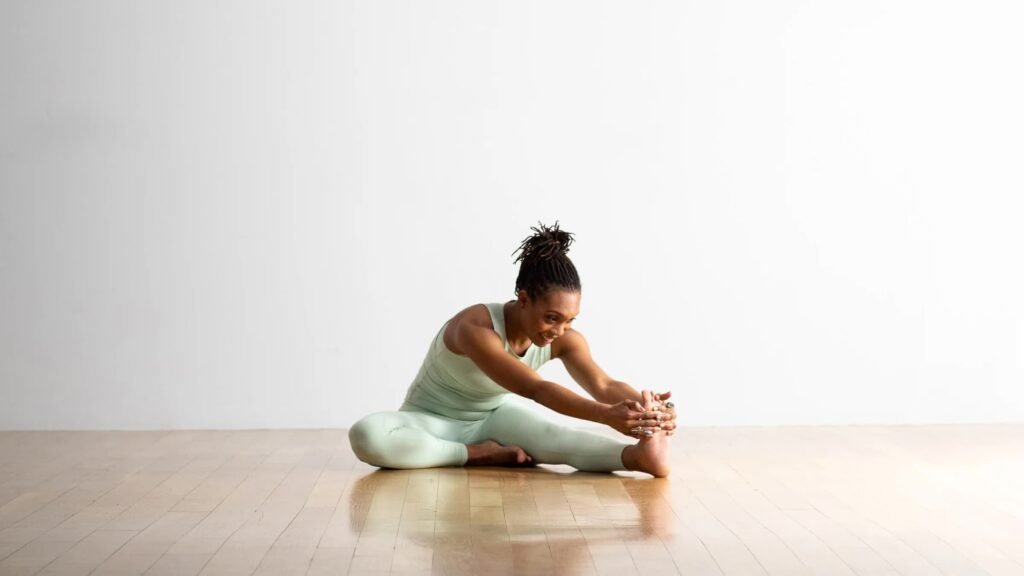
13. Spine Twisting Pose
✔ Sit with one leg straight, other foot outside opposite thigh
✔ Twist towards the bent knee, using arm for leverage
✔ Repeat on the other side
Benefits: Increases spinal flexibility, stimulates the internal organs, and aids digestion.
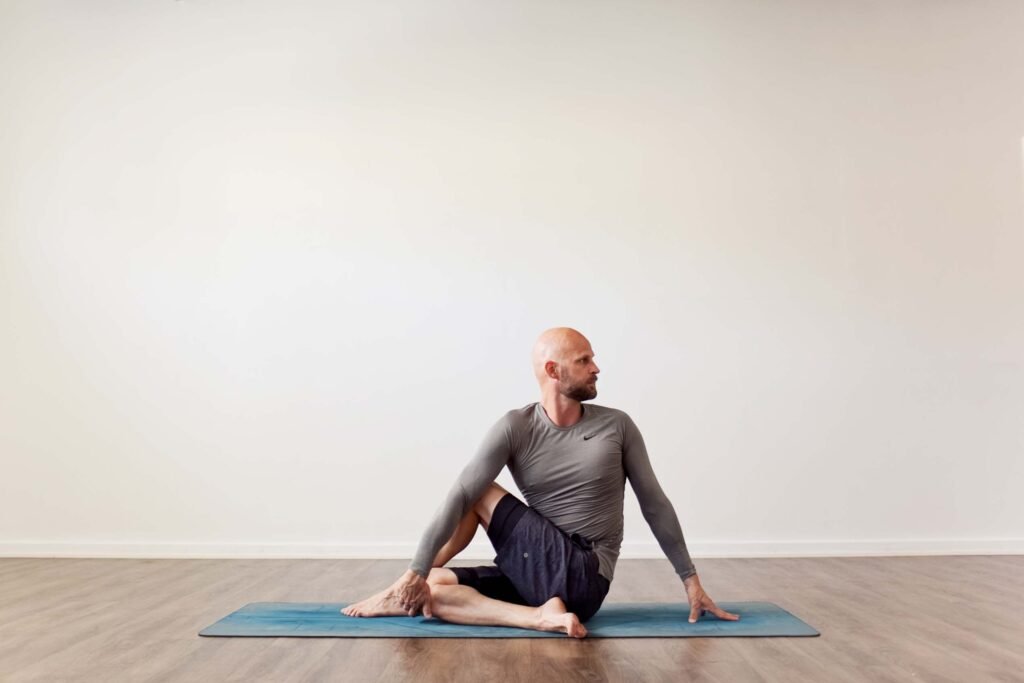
14. Blowing in Firm Pose (Kapalbhati in Vajrasana)
✔ Sit on heels in a kneeling position
✔ Perform quick, forceful exhalations while pumping the abdomen
Benefits: Cleanses the lungs, stimulates abdominal organs, and energizes the body and mind.
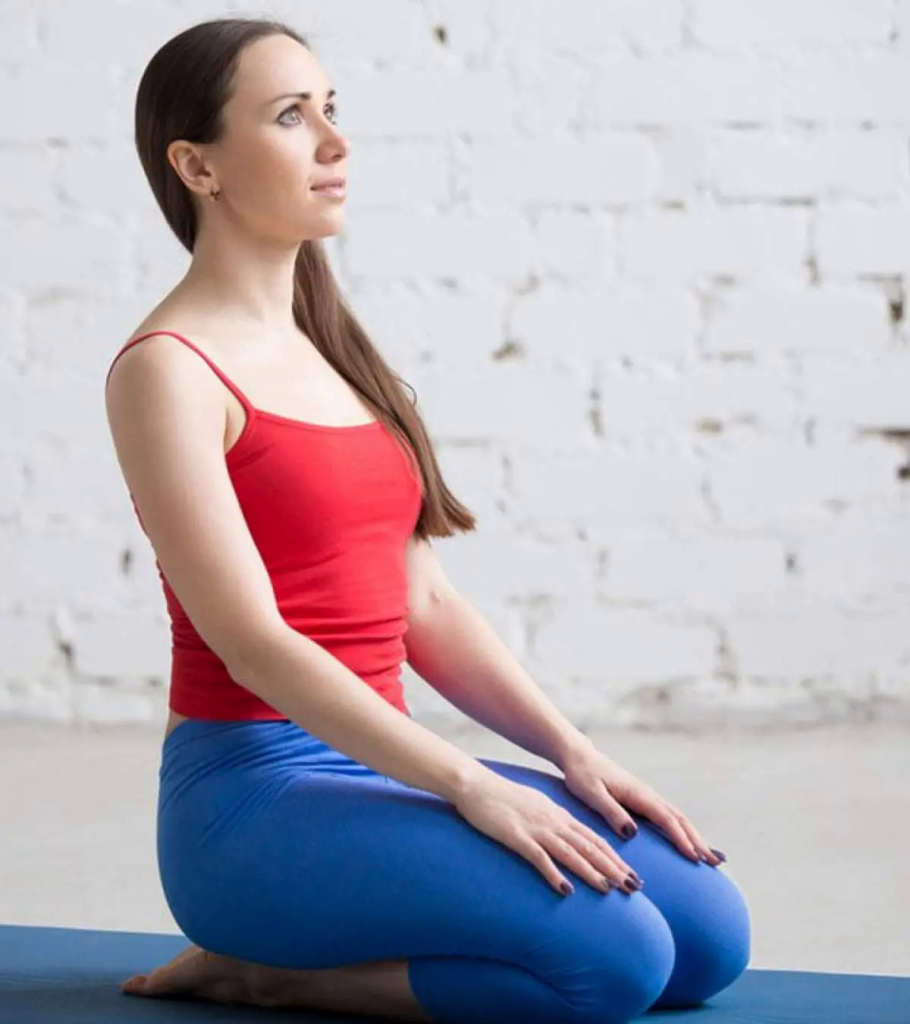
How to Prepare for a Bikram Hot Yoga Class
Preparing for your first Bikram Hot Yoga class can enhance your experience and help you get the most out of this intense practice. Here are some essential tips to ensure you’re ready for the heat and the challenge.
1. Hydration is Key
Drink plenty of water in the days leading up to your class. Staying hydrated is crucial, as the heat in the studio can lead to significant fluid loss through sweating. Aim to drink water regularly, especially on the day of your class, to ensure your body is well-hydrated before you step into the heated room.
2. Mind Your Nutrition
Avoid heavy meals at least two hours before class. Eating light, healthy foods throughout the day can help you feel more comfortable during the session. Foods that are easy to digest, such as fruits, vegetables, and whole grains, are ideal. Steer clear of heavy or greasy meals, as they can make it difficult to perform poses that require abdominal engagement.
3. Dress Appropriately
Wear moisture-wicking clothing that allows for freedom of movement. Many practitioners opt for shorts and a fitted top to help manage sweat and stay cool. Avoid cotton, as it tends to absorb moisture and can become heavy during practice.
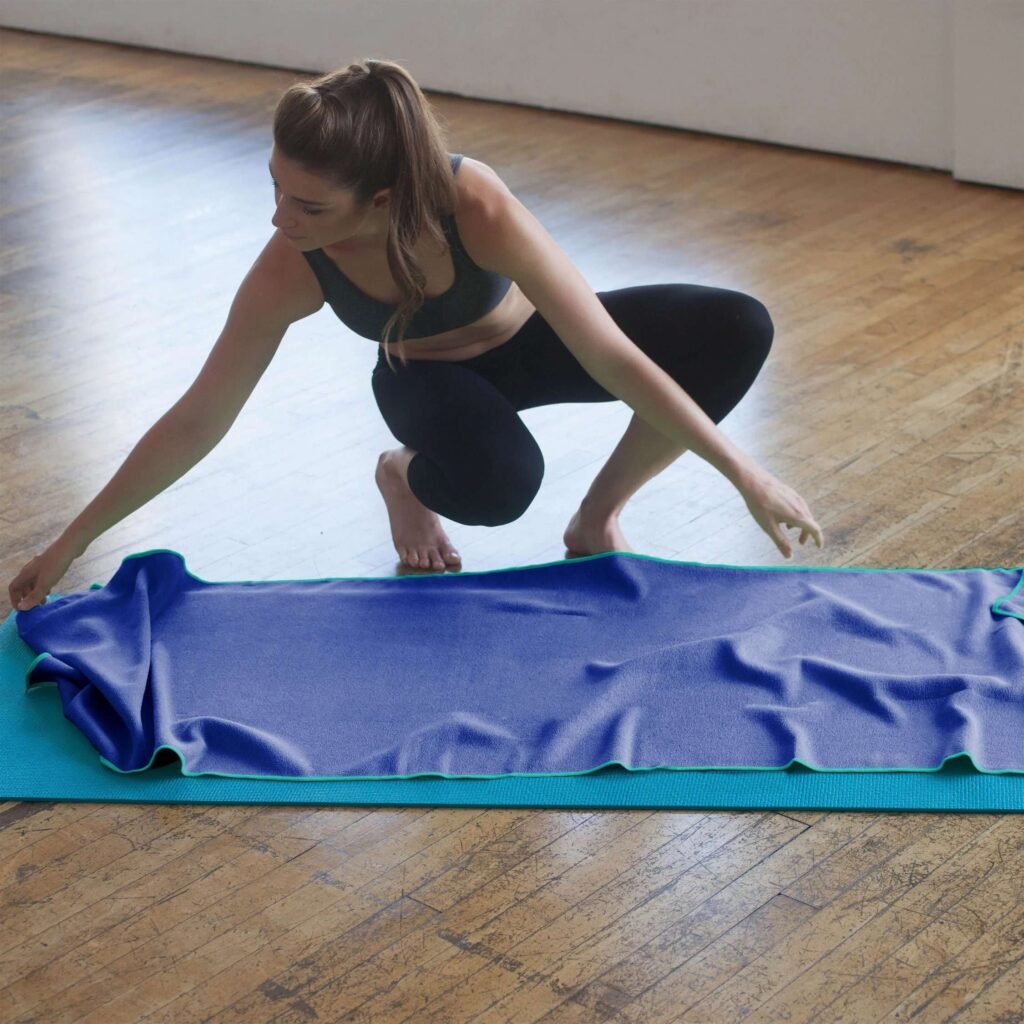
4. Bring the Right Gear
Make sure to bring a yoga mat, a towel (to wipe off sweat), and a water bottle. Some studios provide mats, but having your own can enhance your comfort and hygiene. A towel can also help prevent slipping during poses.
5. Arrive Early
Arriving at least 15-20 minutes early allows you to acclimate to the heat and settle into the space. This time can also be used to set your mat and mentally prepare for the class. Take a moment to breathe deeply and focus on your intentions for the practice.
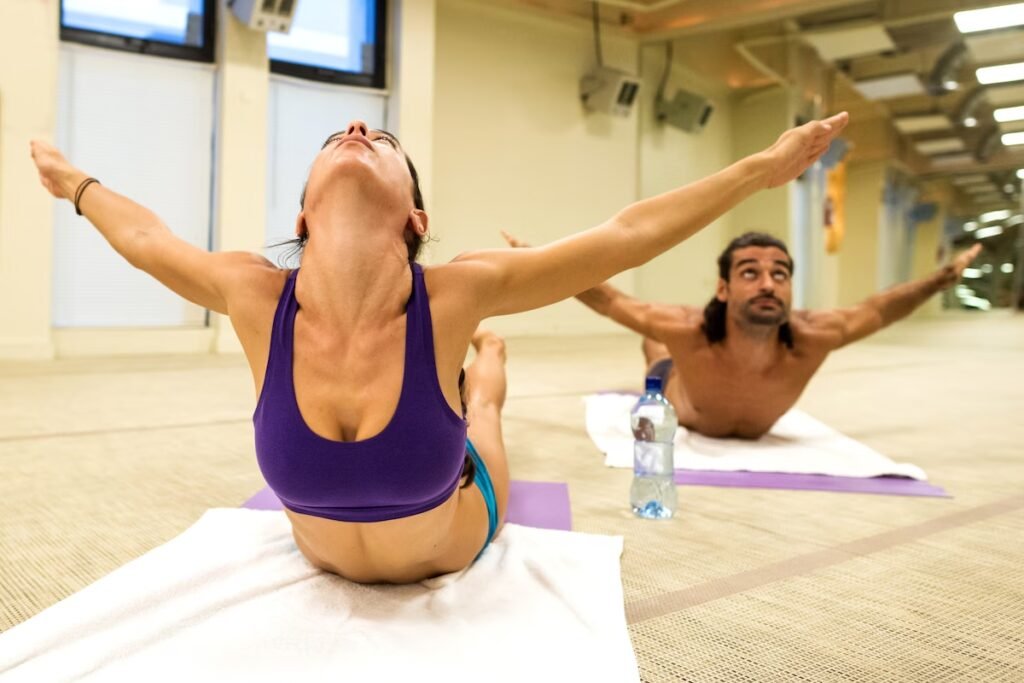
6. Listen to Your Body
As a beginner, it’s essential to listen to your body during the class. If you feel overwhelmed by the heat or experience discomfort, take a break in a resting pose like Child’s Pose or step out of the room for a moment to cool down. Remember, it’s okay to modify poses or skip them altogether if needed. Specially if you’re new to try Bikram Hot Yoga, don’t force yourself.
7. Mental Preparation
Prepare yourself mentally for the class. Bikram Hot Yoga can be intense, and having a positive mindset can help you push through challenges. Focus on your breath and stay present in the moment, allowing yourself to embrace the experience. By following these tips, you’ll be well-prepared to tackle your first Bikram Hot Yoga class with confidence and enthusiasm. Enjoy the journey of self-discovery and transformation that this powerful practice offers!
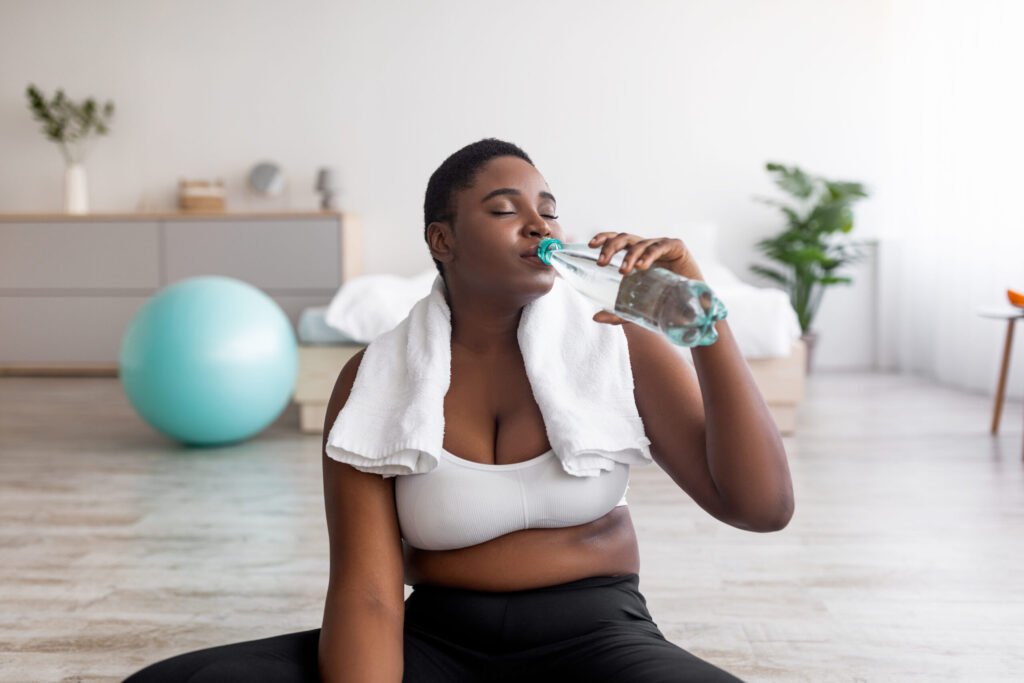
Conclusion
The Bikram Hot Yoga sequence is a challenging yet rewarding practice that offers numerous benefits for both body and mind. From improving flexibility and strength to enhancing cardiovascular health and promoting detoxification, this 26-pose sequence provides a comprehensive workout for the entire body. As with any intense physical practice, it’s essential to listen to your body, stay hydrated, and consult with a healthcare professional before beginning, especially if you have any pre-existing medical conditions. So, try Bikram Hot Yoga, start today!
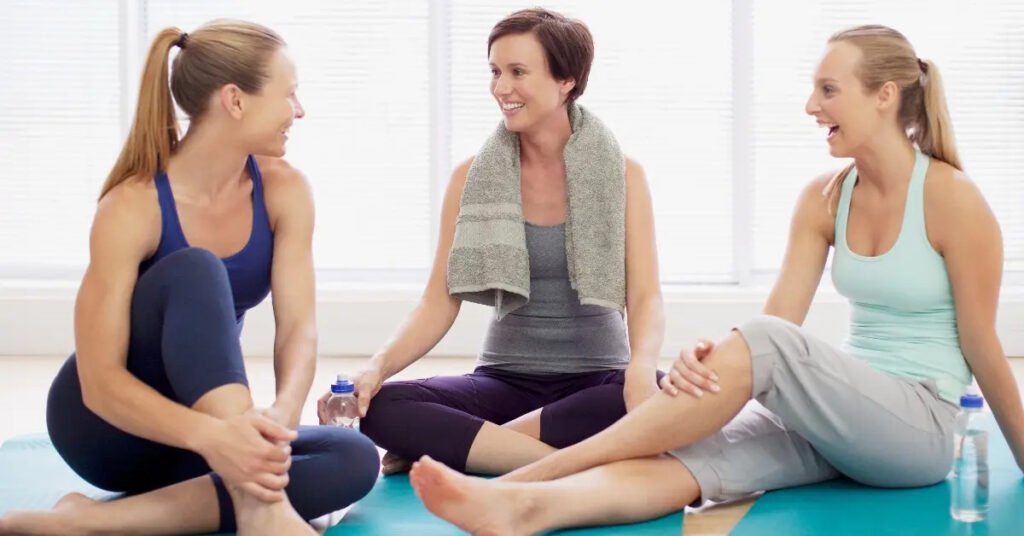
Remember that the heated room intensifies the practice, so it’s crucial to pace yourself and take breaks when needed. By incorporating the Bikram Hot Yoga sequence into your regular wellness routine, you can experience improvements in your physical fitness, mental clarity, and overall well-being. As you progress in your practice, you may find that the benefits extend far beyond the yoga studio, positively impacting various aspects of your daily life.
So, Wellness Warriors, are you ready to embrace the challenge and reap the rewards of the Bikram Hot Yoga sequence? Roll out your yoga mat, step into the hot room, and embark on a transformative journey towards better health and wellness!
